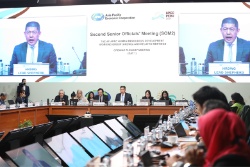Cablegate: Darfur - Malnutition Update
VZCZCXRO4060
PP RUEHGI RUEHMA RUEHROV
DE RUEHKH #1297/01 2311407
ZNR UUUUU ZZH
P 191407Z AUG 07
FM AMEMBASSY KHARTOUM
TO RUEHC/SECSTATE WASHDC PRIORITY 8244
INFO RUCNFUR/DARFUR COLLECTIVE PRIORITY
RUEHRN/USMISSION UN ROME
UNCLAS SECTION 01 OF 02 KHARTOUM 001297
SIPDIS
AIDAC
SIPDIS
STATE FOR AF/SPG, PRM, AND ALSO PASS USAID/W
USAID FOR DCHA SUDAN TEAM, AFR/SP
NAIROBI FOR USAID/DCHA/OFDA, USAID/REDSO, AND FAS
GENEVA FOR NKYLOH
NAIROBI FOR SFO
NSC FOR PMARCHAM, MMAGAN, AND TSHORTLEY
ADDIS ABABA FOR USAU
USUN FOR TMALY
BRUSSELS FOR PBROWN
E.O. 12958: N/A
TAGS: EAID PREF PGOV PHUM SOCI UN SU
SUBJECT: DARFUR - MALNUTITION UPDATE
KHARTOUM 00001297 001.2 OF 002
1. Summary: The UN Office for the Coordination of Humanitarian
Affairs (OCHA) reports that recent Darfur nutrition survey results
indicate the first significant increase in malnutrition in the
region since 2004. According to USAID partner the UN Children's
Fund (UNICEF), six localized nutrition surveys conducted in May and
June -- two in North Darfur, three in South Darfur, and one in West
Darfur -- found global acute malnutrition (GAM) rates above the
emergency threshold of 15 percent. In three of the six surveys,
rates were above 2006 levels. Although exact causes for the
increased rates require further investigation, UNICEF identified
population movement, persistent insecurity resulting in diminished
beneficiary access to services, and inadequate water and sanitation
services as contributing factors.
2. Humanitarian agencies continue to provide essential health and
nutrition services and adjust response efforts to meet increased
needs. USAID funds nutrition programs in all three Darfur states
through implementing partners Action Contre la Faim (ACF), Save the
Children/United States (SC/US), Relief International, GOAL, and
UNICEF. End summary.
----------------------------------
LOCALIZED NUTRITION SURVEY RESULTS
----------------------------------
3. On August 1, UNICEF released the results of six localized
nutrition surveys conducted in Kabkabiya, Abu Shouk and As Salaam
internally displaced person (IDP) camps, Al Salam IDP camp, Otash
IDP camp, Kass, and El Geneina town and IDP camps, indicating GAM
rates above the emergency threshold of 15 percent. While an
increase in GAM rates is in line with seasonal trends, survey
results for three locations in North and West Darfur were higher
than 2006 levels. For the three surveys conducted in South Darfur,
comparable 2006 data was not available. UNICEF has also observed a
recent increase in supplementary feeding center (SFC) admissions for
moderate malnutrition and an increase in therapeutic feeding center
(TFC) admissions for treatment of severe malnutrition in Darfur.
Recent survey results indicate the first significant increase in
malnutrition in the Darfur region since late 2004, according to
OCHA.
--------------------
CONTRIBUTING FACTORS
--------------------
4. UNICEF and partners are further investigating underlying causes
for the increase in malnutrition rates, but have highlighted
insecurity, population movements, and inadequate water and
sanitation conditions as contributing factors. UNICEF emphasized
the role of insecurity in preventing humanitarian agencies from
providing sustained, quality services in program areas, as well as
reducing beneficiary access to existing health and nutrition
services.
UNICEF also noted the impact of the Sudanese government ban on the
use of F100 and F75 therapeutic milk, following quality concerns of
stocks in Khartoum. Although the temporary ban from April 7 to July
4 was not systematically applied, UNICEF reported increased rates of
diarrheal disease where therapeutic milks were not being used.
---------------------
HUMANITARIAN RESPONSE
---------------------
5. Humanitarian agencies continue to provide essential health and
nutrition services and adjust response efforts to meet increased
needs. In Al Salam IDP camp in South Darfur, USAID partner ACF has
expanded its SFC to serve 500 beneficiaries per week and its
outpatient therapeutic program to serve 250 severely malnourished
children per week. USAID funds nutrition programs in all three
Darfur states through implementing partners ACF, SC/US, Relief
International, GOAL, and UNICEF. Despite sufficient funds to
support emergency interventions, UNICEF notes that insecurity
prevents access to certain areas and fewer organizations are
currently working in the nutrition sector than in 2006.
6. UNICEF is undertaking a thorough review of all nutrition
information to identify gaps and underlying causes of the decline.
In addition, from August 11 to September 10, interagency assessments
are being conducted in the region as part of the annual emergency
KHARTOUM 00001297 002.2 OF 002
food security and nutrition assessment, with results expected in
mid-October. In September, a USAID/OFDA and Centers for Disease
Control nutrition specialist will be deployed to Darfur to assess
the overall nutrition situation and inform USAID programming
response to emerging nutrition needs.
POWERS


 Being LBGTI in Asia: UNDP And ILGA World Launch The International Pride Awards, Recognising LGBTIQ+ Equality Champions
Being LBGTI in Asia: UNDP And ILGA World Launch The International Pride Awards, Recognising LGBTIQ+ Equality Champions UN News: UN Teams Dispatch Aid As Deadly Flash Floods Hit Northern Afghanistan
UN News: UN Teams Dispatch Aid As Deadly Flash Floods Hit Northern Afghanistan Save The Children: It’s Not Safe And It’s Not Clean, But People Believe They Are Leaving Something Worse Behind
Save The Children: It’s Not Safe And It’s Not Clean, But People Believe They Are Leaving Something Worse Behind APEC: APEC Commits To Empowering People With Disabilities
APEC: APEC Commits To Empowering People With Disabilities UN News: Israeli Forces Bringing War To The West Bank, Warns UN Rights Office
UN News: Israeli Forces Bringing War To The West Bank, Warns UN Rights Office UN News: 10,000 People Feared Buried Under The Rubble In Gaza
UN News: 10,000 People Feared Buried Under The Rubble In Gaza